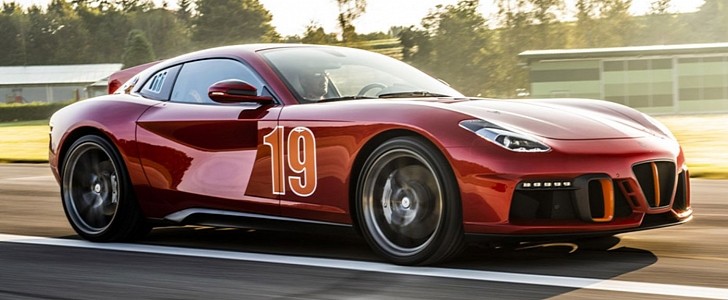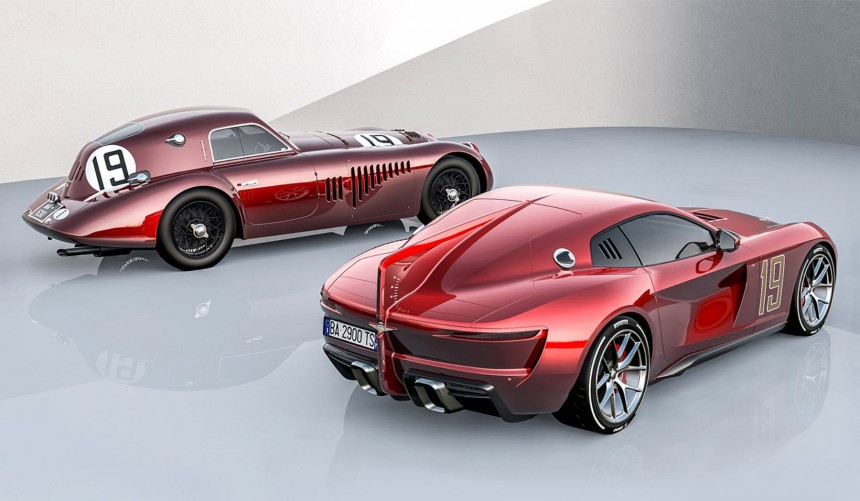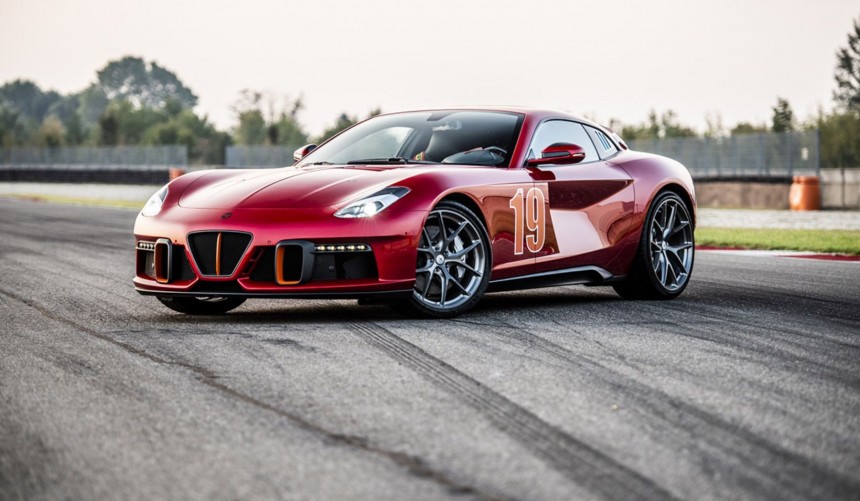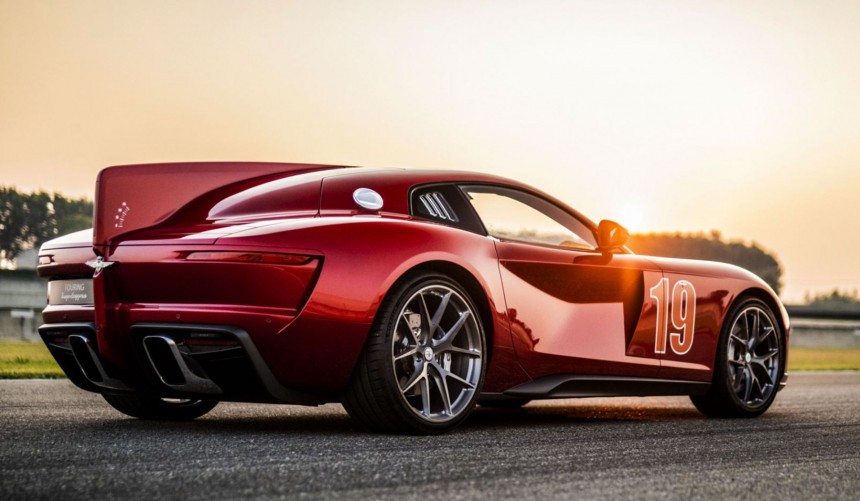One of the most prestigious Italian coachbuilders, Carrozzeria Touring Superleggera has produced a number of timeless automotive masterpieces until the industry’s technological advancements led to its demise. The company eventually rose from its ashes and the Aero 3 proves that it's still able to deliver breathtaking products.
Coachbuilding, or the art of crafting custom bodies for passenger-carrying vehicles, has been around for ages. As the name implies, its origins can be traced back to horse-drawn coaches or carriages. It went on the reach new heights during the first part of the 20th century, as a consequence of the automobile industry’s birth and fast-paced development.
Apart from the established coachbuilders who successfully made the transition from coaches and carriages to cars, this period also saw the emergence of new companies all across the world.
One of them was born in Milan, Italy, back in 1926 when two wealthy locals, Felice Bianchi Anderloni and Gaetano Ponzoni, purchased Carrozzeria Falco form founder Vittorio Ascari and renamed it Carrozzeria Touring. Anderloni, a former test driver for Isotta Fraschini and Peugeot Italia employee became the chief designer, while Ponzoni assumed responsibility for all business activities.
Early work included projects for Alfa Romeo, Citroën, or Isotta Fraschini, but the company rose to prominence after Anderloni developed a custom tube and alloy panel construction system dubbed Superleggera in the latter half of the 1930s. During the next couple of decades, Touring grew into one of the most successful coachbuilders in Europe, designing bodies that were not only gorgeous but also light and aerodynamic. Its main customers were fellow Italians Alfa Romeo and Ferrari, both of which flourished on the road and track with Superleggera-bodied models.
Their innovative system was subsequently licensed by other manufacturers, the Milanese coachbuilder was obviously the best at it, so it became known as Carrozzeria Touring Superleggera.
Although renowned all over the world for their masterful craftsmanship, the automotive industry’s embrace of unibody construction during the 1950s and 1960s made it difficult and more expensive for Touring Superleggera to develop custom bodies. Interest decreased and finally, in 1966, the legendary firm ceased its operations.
Over the next four decades, the trademark was resurrected on a few projects by Carrozzeria Marazzi, but it wasn’t until 2006 that the company truly rose from its ashes thanks to a group of private investors that brought the rights for the name from the original founders’ descendants.
Modern masterpieces followed, and arguably the most interesting of them is the 2020 Aero 3. Based on the Ferrari F12berlinetta, it was conceived as a limited production, high-performance track weapon that combines state-of-the-art aerodynamics with daring styling cues inspired by classic Touring Superleggera-designed Alfas.
Apart from the multitude of aggressive lines, vents, and the V-shaped grille that’s clearly a nod to the historical ties with Alfa Romeo (even without featuring an official badge), the completely redesigned, coach-built body’s most striking feature is the large rear fin. Even though Touring admits that the element serves no aerodynamic function, it gives the Aero 3 a distinctively racy appearance and reminds enthusiasts of Alfa Corse’s 1938 8C 2900B Le Mans Speciale.
While the fin is more of a design statement than a performance-enhancing component, the company claims that all other sections of the lightweight carbon-fiber body were developed and wind tunnel-tested to make the car as aerodynamically efficient as possible. Examples of this range from the huge front bumper ducts that improve downforce as well as brake cooling, to the shape of the wheel arches or side mirrors which were extensively wind-tunnel tested.
Under the hood, the gorgeous track car hides a 6.3-liter FC version of Ferrari’s modern engineering wonder, the F140 V12. Touring states that output is rated at 740 hp and 509 lb-ft (690 Nm) of torque. These figures are the same as those of the F12berlinetta, which means that the engine has received any noteworthy modifications. Moreover, with a 0 to 62 mph (100 kph) acceleration time of 3.1 seconds and a top speed of 211 mph (340 kph), the Aero 3 is just as fast as the Ferrari grand tourer it was based on.
Taking all this into account, some will say that the car doesn’t live up to its name and it’s just a re-bodied F12berlinetta that doesn’t seem to come with any real aerodynamic enhancements. While that may be true, in my opinion, the Aero 3 is not necessarily about performance (what it offers, is more than enough), but serves as proof that Italian coachbuilding is alive and well.
It’s hard not to like its hand-crafted body that does a beautiful job honoring Carrozzeria Touring Superleggera’s iconic designs and makes for a far more appealing alternative to the model it was based on.
Only 15 examples of the Aero 3 were produced, each personalized to the owner’s requirements. As for the pricing, a figure was never publicly released, but from what we heard through the grapevine, the conversion cost at least $300.000, secluding the price of the donor car.
Apart from the established coachbuilders who successfully made the transition from coaches and carriages to cars, this period also saw the emergence of new companies all across the world.
One of them was born in Milan, Italy, back in 1926 when two wealthy locals, Felice Bianchi Anderloni and Gaetano Ponzoni, purchased Carrozzeria Falco form founder Vittorio Ascari and renamed it Carrozzeria Touring. Anderloni, a former test driver for Isotta Fraschini and Peugeot Italia employee became the chief designer, while Ponzoni assumed responsibility for all business activities.
Early work included projects for Alfa Romeo, Citroën, or Isotta Fraschini, but the company rose to prominence after Anderloni developed a custom tube and alloy panel construction system dubbed Superleggera in the latter half of the 1930s. During the next couple of decades, Touring grew into one of the most successful coachbuilders in Europe, designing bodies that were not only gorgeous but also light and aerodynamic. Its main customers were fellow Italians Alfa Romeo and Ferrari, both of which flourished on the road and track with Superleggera-bodied models.
Although renowned all over the world for their masterful craftsmanship, the automotive industry’s embrace of unibody construction during the 1950s and 1960s made it difficult and more expensive for Touring Superleggera to develop custom bodies. Interest decreased and finally, in 1966, the legendary firm ceased its operations.
Over the next four decades, the trademark was resurrected on a few projects by Carrozzeria Marazzi, but it wasn’t until 2006 that the company truly rose from its ashes thanks to a group of private investors that brought the rights for the name from the original founders’ descendants.
Modern masterpieces followed, and arguably the most interesting of them is the 2020 Aero 3. Based on the Ferrari F12berlinetta, it was conceived as a limited production, high-performance track weapon that combines state-of-the-art aerodynamics with daring styling cues inspired by classic Touring Superleggera-designed Alfas.
While the fin is more of a design statement than a performance-enhancing component, the company claims that all other sections of the lightweight carbon-fiber body were developed and wind tunnel-tested to make the car as aerodynamically efficient as possible. Examples of this range from the huge front bumper ducts that improve downforce as well as brake cooling, to the shape of the wheel arches or side mirrors which were extensively wind-tunnel tested.
Under the hood, the gorgeous track car hides a 6.3-liter FC version of Ferrari’s modern engineering wonder, the F140 V12. Touring states that output is rated at 740 hp and 509 lb-ft (690 Nm) of torque. These figures are the same as those of the F12berlinetta, which means that the engine has received any noteworthy modifications. Moreover, with a 0 to 62 mph (100 kph) acceleration time of 3.1 seconds and a top speed of 211 mph (340 kph), the Aero 3 is just as fast as the Ferrari grand tourer it was based on.
It’s hard not to like its hand-crafted body that does a beautiful job honoring Carrozzeria Touring Superleggera’s iconic designs and makes for a far more appealing alternative to the model it was based on.
Only 15 examples of the Aero 3 were produced, each personalized to the owner’s requirements. As for the pricing, a figure was never publicly released, but from what we heard through the grapevine, the conversion cost at least $300.000, secluding the price of the donor car.





















